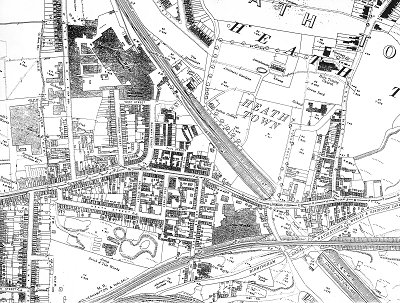|
HEATH TOWN PUBLIC BATHS AND LIBRARY
page 2
| Public libraries and baths were a Victorian response to the growth of
industrial, urban society (Best 1979, 55, 58, 83); correspondingly
Wolverhampton, a growing urban and industrial centre, acquired baths in
1851 (Wolverhampton Borough Council 1948, 134) and a public library in
1869 (ibid., 140). Despite the economic dislocations of the First World
War and its aftermath, urban industrial society continued to evolve in
the early 20th century; calls for further baths and library provision
naturally followed. In Wolverhampton these developments took place
within a particular, local context: the absorption by the borough of
previously independent neighbouring communities. One of these was Heath
Town. Heath Town originated as the tiny settlement of "Wednesfield Heath"
midway between Wednesfield and Wolverhampton. With the onset of
industrialisation in the 18th century it steadily grew and changed. The
canal arrived in 1797, the railway in 1837; in 1850 Heath Town became a
parish, and in 1893 an Urban District. At the time of the First World
War it was a small but compact settlement of terraced houses around the
shops, public houses and new church clustered along the Wednesfield
Road, slightly to the west of the 1852 parish church (Brew 1999, 7, 11).
|

Ordnance Survey map 1919 showing the Heath
Town area. The baths and library came to be built at the
bend in Tudor Road, running northwards from the main railway
line. |
Compact community it might be, but Heath Town was too small
to avoid absorption by its growing western neighbour,
Wolverhampton. The residents themselves first proposed the move,
in 1901, but changed their mind (Mason 1982, 30).
Wolverhampton revived the idea in 1919, and its
implementation was only halted by a sudden shift in central
government policy. The Borough tried again in 1926, and, despite
opposition from Heath Town, it was successful: the district
became part of Wolverhampton from 1 April 1927 (Wolverhampton
Borough Council 1926, 149ff, 1034ff). |
| Crucially for our purposes, the move went ahead on the basis of
undertakings given to Heath Town during negotiations at Westminster;
among these were the promise of both baths and library (CMB/WOL/D/LIB
128.6; Wolverhampton Borough Council 1930, 654). The fulfillment of the promise was to be a long and somewhat tortuous
process, reflecting the enlarged Council's native caution in spending
ratepayers' money, and the national economic crisis which followed the
Crash of October 1929. The details can be pursued in the records of the
Council and its two relevant Committees. Decisive moments were 8 July
1929, when approval was given for branch Libraries at Bushbury (another
recently absorbed district) and Heath Town (Wolverhampton Borough
Council 1929, 626); 16 June 1930, when a combined baths and library
building for Heath Town was agreed (Wolverhampton Borough Council 1930,
636, 659); and 25 October 1931, when the government finally approved
loan arrangements to finance the project (CMB/WOL/C/PB/25, 72). Over the
whole process, three points stand out. First, the notion of combining
library and other services in one building was mooted as early as
December 1926 (CMB/WOL/D/LIB/128.6), and kept cropping up thereafter in
one or other Committee, or in Council; the motive throughout was
economy. Secondly, despite the presence of this notion, the Library and
Baths Committees mostly worked independently of one another; however at
crucial moments, and particularly over the 5 months preceding the vital
Council decision of June 1930, they collaborated (Wolverhampton Borough
Council 1930, 632). Thirdly, the key to their co-operation was the
Council Officer in charge of building design for both, the Borough
Surveyor and Engineer, H B Robinson M. Inst. M. & C. Eng. His reward was
the formal opening of the new baths on 16 December 1932 and the library
on 23 May 1933: notable civic occasions, duly reported in the local
press (Express and Star 17th December 1932 and 24th
May 1933).
|
 |
|
 |
Return to the
previous page |
|
Proceed to the
next page |
|